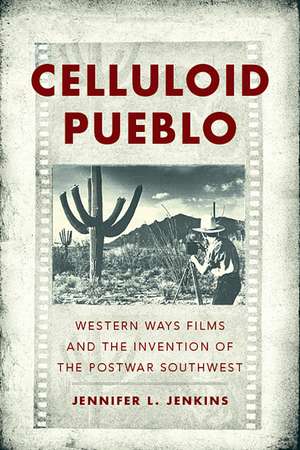Celluloid Pueblo: Western Ways Films and the Invention of the Postwar Southwest
Autor Jennifer L. Jenkinsen Limba Engleză Hardback – 18 oct 2016
The five Cs of Arizona—copper, cattle, cotton, citrus, and climate—formed the basis of the state’s livelihood and a readymade roster of subjects for films. With an eye on the developing national appetite for all things western, Charles and Lucile Herbert founded Western Ways Features in 1936 to document the landscape, regional development, and diverse cultures of Arizona, the U.S. Southwest, and northern Mexico.
Celluloid Pueblo tells the story of Western Ways Features and its role in the invention of the Southwest of the imagination. Active during a thirty-year period of profound growth and transformation, the Herberts created a dynamic visual record of the region, and their archival films now serve as a time capsule of the Sunbelt in the mid-twentieth century. Drawing upon a ten-year career with Fox, Western Ways owner-operator Charles Herbert brought a newshound’s sensibility and acute skill at in-camera editing to his southwestern subjects. The Western Ways films provided counternarratives to Hollywood representations of the West and established the regional identity of Tucson and the borderlands.
Jennifer L. Jenkins’s broad-sweeping book examines the Herberts’ work on some of the first sound films in the Arizona borderlands and their ongoing promotion of the Southwest. The book covers the filmic representation of Native and Mexican lifeways, Anglo ranching and leisure, Mexican missions and tourism, and postwar borderlands prosperity and progressivism. The story of Western Ways closely follows the boom-and-bust arc of the midcentury Southwest and the constantly evolving representations of an exotic—but safe and domesticated—frontier.
Celluloid Pueblo tells the story of Western Ways Features and its role in the invention of the Southwest of the imagination. Active during a thirty-year period of profound growth and transformation, the Herberts created a dynamic visual record of the region, and their archival films now serve as a time capsule of the Sunbelt in the mid-twentieth century. Drawing upon a ten-year career with Fox, Western Ways owner-operator Charles Herbert brought a newshound’s sensibility and acute skill at in-camera editing to his southwestern subjects. The Western Ways films provided counternarratives to Hollywood representations of the West and established the regional identity of Tucson and the borderlands.
Jennifer L. Jenkins’s broad-sweeping book examines the Herberts’ work on some of the first sound films in the Arizona borderlands and their ongoing promotion of the Southwest. The book covers the filmic representation of Native and Mexican lifeways, Anglo ranching and leisure, Mexican missions and tourism, and postwar borderlands prosperity and progressivism. The story of Western Ways closely follows the boom-and-bust arc of the midcentury Southwest and the constantly evolving representations of an exotic—but safe and domesticated—frontier.
Preț: 357.64 lei
Preț vechi: 425.34 lei
-16% Nou
Puncte Express: 536
Preț estimativ în valută:
68.49€ • 70.57$ • 57.38£
68.49€ • 70.57$ • 57.38£
Carte indisponibilă temporar
Doresc să fiu notificat când acest titlu va fi disponibil:
Se trimite...
Preluare comenzi: 021 569.72.76
Specificații
ISBN-13: 9780816502653
ISBN-10: 081650265X
Pagini: 248
Ilustrații: 53 halftones
Dimensiuni: 152 x 229 x 24 mm
Greutate: 0.48 kg
Ediția:1
Editura: University of Arizona Press
Colecția University of Arizona Press
ISBN-10: 081650265X
Pagini: 248
Ilustrații: 53 halftones
Dimensiuni: 152 x 229 x 24 mm
Greutate: 0.48 kg
Ediția:1
Editura: University of Arizona Press
Colecția University of Arizona Press
Notă biografică
Jennifer L. Jenkins teaches in both the English department and the School of Information at the University of Arizona. Her work has appeared in the journals ESQ, the Henry James Review, Twentieth-Century Literature, Journal of Popular Culture, and The Moving Image. She has curated the Puro Mexicano Tucson Film Festival.
Cuprins
Preface: Adventures in the Archives; or, Bringing Film Back to Light
Acknowledgments
1 Establishing Shots: Southwest Borderlands as Spectacle
2 Sights and Sounds: Fox Movietone Visits Arizona in 1929
3 Missions and Mexico
4 Framing Race in the Arizona Borderlands
5 From Silver Screen to Small Screen
Epilogue: Fade to Black
Appendix: Complete Herbert Filmography
Notes
Bibliography
Selected Filmography
Illustration Credits
Index
Acknowledgments
1 Establishing Shots: Southwest Borderlands as Spectacle
2 Sights and Sounds: Fox Movietone Visits Arizona in 1929
3 Missions and Mexico
4 Framing Race in the Arizona Borderlands
5 From Silver Screen to Small Screen
Epilogue: Fade to Black
Appendix: Complete Herbert Filmography
Notes
Bibliography
Selected Filmography
Illustration Credits
Index
Recenzii
“[This] critical examination of the Western Ways films illustrates how one independent filmmaker reinforced and challenged the dominant images of the Southwest produced by Hollywood, and romanticized art and representations that promoted the region for commerce.”—Mark Neumann, co-author of Recording Culture: Audio Documentary and the Ethnographic Experience
“A welcome glimpse back in time to a beloved area.”—Southwestern Historical Quarterly
“Jenkins has a keen eye for cinematic and ethnographic complexity; she demonstrates both the documentary significance of the films and their complex engagements with perspective, performance, and power.”—Western Literature Association
“Jenkins has a keen eye for cinematic and ethnographic complexity; she demonstrates both the documentary significance of the films and their complex engagements with perspective, performance, and power.”—Western Literature Association
Descriere
Celluloid Pueblo tells the story of Western Ways Features and its role in the invention of the Southwest of the imagination. The story closely follows the boom-and-bust arc of this region in the mid-twentieth century and the constantly evolving representations of an exotic—but safe and domesticated—frontier and the landscape, regional development, and diverse cultures of Arizona and the Southwest.
